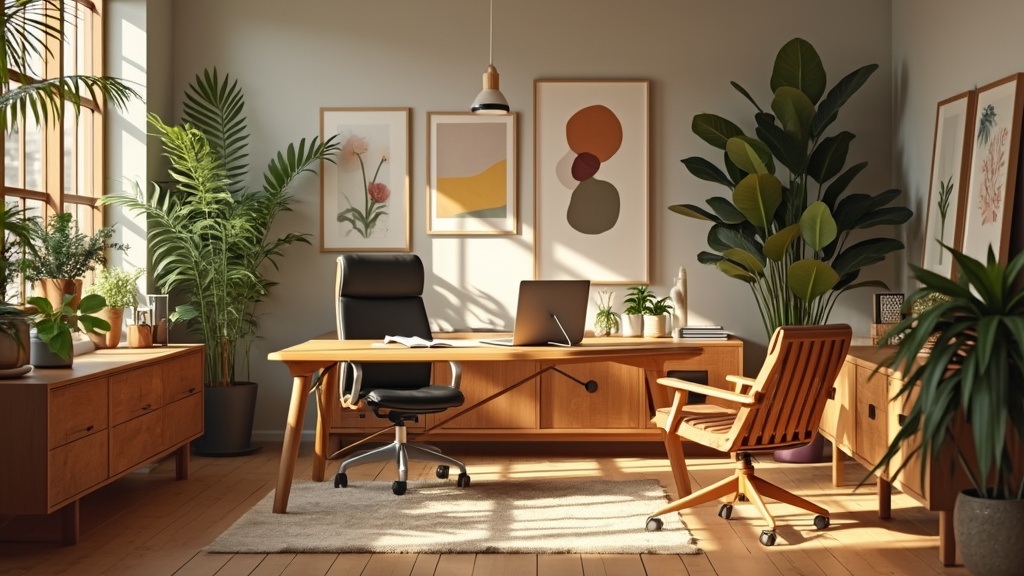Transforming a living environment, handmade case goods embody both artistry and functionality. These unique furnishings often utilize locally sourced materials, which supports sustainable practices and promotes eco-friendly furniture options.
Custom furniture pieces can increase the value of a home by 20%, thanks to their distinctive design and quality craftsmanship.
These decorative case goods not only serve practical purposes but also enhance the overall aesthetic appeal of any space.
Choosing artisan-crafted items can create inviting spaces that truly reflect individual style.
Click here to learn more about: scandinavian furniture
Artisan Techniques in Furniture Craftsmanship
Delving into artisan woodworking reveals the significance of traditional craftsmanship in modern design. Artisan craftsmanship revives bespoke design principles, bridging the gap between heritage and contemporary needs.
Techniques like dovetail joinery exemplify quality craftsmanship; these joints produce enduring strength and durability, enhancing the longevity of customized pieces. This time-honored method provides creative storage solutions while maintaining aesthetic appeal.
Dovetail joints are a hallmark of fine woodworking; their presence often signifies a commitment to artistry and functional elegance in handcrafted items.
Significance of Quality Craftsmanship
The true value of artisan furniture lies in its meticulous construction.
Each component reflects the skill of local artisans who follow traditional methods.
This craftsmanship heritage ensures that every piece is not only visually stunning but also practical. Investing in eco-conscious products supports a sustainable future while enriching home furnishings with unique designs.
The blend of artistry and function results in statement pieces that resonate with both beauty and purpose.

What Makes Custom Cabinetry Unique
Custom cabinetry exemplifies a convergence of aesthetics, sustainability, and functionality, making it a remarkable choice for homeowners. Individuals can opt for sustainable decor by selecting ecofriendly materials that effectively minimize their environmental footprint.
This selection process not only enhances interior decor but also promotes responsible sourcing practices.
Personalization within cabinetry plays a crucial role; tailored dimensions and finishes empower individuals to articulate their unique style.
For example, incorporating integrated lighting or pull-out spice racks significantly enhances functionality while preserving an elegant appearance. Such creative storage solutions elevate both the utility and aesthetic appeal of custom cabinetry, presenting a worthwhile investment for any home.
Exploring Bespoke Design Principles
Delving into bespoke design highlights the importance of handcrafted items and their reflection of personal style.
This approach allows for deeper connections to one’s living space, as every piece embodies individual stories and tastes. With quality craftsmanship, bespoke creations can be tailored in material, color, and form, fostering a rich narrative within a home.
A practical tip for collaborating with designers involves engaging in open dialogue, ensuring that inspirations and preferences are conveyed clearly.
Employing mood boards or samples can visually enhance communication, allowing the final outcome to resonate with personal style while meeting expectations in artistic functionality.
Custom Cabinetry
- Custom cabinetry can increase a home’s value by up to 20% due to its unique design and quality materials.
- Using eco-friendly materials in cabinetry reduces carbon emissions by approximately 30% compared to traditional materials.
- Personalized cabinetry solutions can improve space efficiency by up to 50%, maximizing storage and functionality.
- Incorporating integrated lighting can enhance visibility and ambiance, making spaces feel larger and more inviting.
Benefits Of Sustainable Decor Choices
Exploring sustainable decor choices provides a pathway to enhance both environmental impact and aesthetic appeal. Sustainable materials contribute significantly to the durability of furnishings, ensuring these pieces remain functional for longer periods, thereby reducing waste.
For instance, bamboo furniture is celebrated for its strength and beauty, delivering an impressive combination of form and function.
Utilizing recycled or responsibly sourced materials not only elevates your decor but also plays a role in minimizing your carbon footprint.
Such unique materials introduce vibrant textures and rich narratives to your home, enhancing overall aesthetic appeal while promoting eco-friendly practices.
Consider the following advantages of sustainable decor:
- Durability: Sustainable materials often outlast conventional options, reducing the need for replacements.
- Aesthetic Value: Unique textures and designs can create visually appealing environments.
- Environmental Impact: Reducing waste and carbon footprints contributes positively to the planet.
How To Choose Unique Furnishings
Exploring uniqueness in furnishings transforms living spaces into authentic reflections of personal style. Artisan craftsmanship significantly influences the distinction of each piece, enhancing depth and character within your decor. Familiarity with various craftsmanship techniques, such as hand-carving or weaving, unveils remarkable possibilities in furniture design. Supporting local artisans remains essential; these creators often produce customized pieces that resonate deeply with individual tastes.
Here are some tips for sourcing unique furnishings:
“Seek out local artisan markets and online platforms featuring handmade goods to discover one-of-a-kind creations that infuse character and warmth into your home. ”.
- Visit artisan workshops: Engaging with local artisans can reveal insights into their craftsmanship techniques.
- Explore boutique stores: Specialty shops often curate distinctive selections of furniture and decor.
- Attend craft fairs: These events showcase a variety of unique, handmade items that reflect craftsmanship heritage.
| Benefits of Sustainable Decor | Choosing Unique Furnishings |
|---|---|
| Durability: Often outlasts conventional options. | Artisan Craftsmanship: Enhances depth and character. |
| Aesthetic Value: Creates visually appealing environments. | Support Local Artisans: Customized pieces resonate with individual tastes. |
| Environmental Impact: Reduces waste and carbon footprints. | Explore Boutique Stores: Distinctive selections of furniture and decor. |
The Importance Of Handcrafted Items
Handcrafted items resonate with quality and uniqueness, distinguishing them from mass-produced alternatives. Artisan craftsmanship focuses on using sustainable materials, ensuring that handmade case goods not only look stunning but also stand the test of time.
Each handcrafted piece conveys a personal story, allowing homeowners to express their individuality through personalized furniture.
For instance, a handcrafted wooden coffee table made from reclaimed wood serves both as a functional piece and a conversation starter.
Its unique grain patterns and refined finishes highlight the artisan’s skill, making it a treasured addition to any living space.
Craftsmanship Techniques In Handmade Case Goods
Artisan techniques enhance the longevity of handmade case goods, ensuring they remain functional and beautiful for years. Traditional methods such as dovetail joinery reinforce furniture, preventing wear from daily use.
Artisans prioritize eco-friendly materials, minimizing waste and environmental impact during production. To assess quality in handmade items, consider the following tips:
- Examine for signs of meticulous craftsmanship, including smooth finishes.
- Check for precise alignments that demonstrate attention to detail.
- Opt for items constructed from solid wood instead of particle board, which exemplify durability and enhance aesthetic appeal.
These elements solidify their place as heirloom quality furnishings in your home, reflecting a commitment to both artistry and sustainability.
| Feature | Handcrafted Items | Mass-Produced Items |
|---|---|---|
| Quality | High, with artisan craftsmanship | Variable, often lower quality |
| Materials | Sustainable, eco-friendly | Often synthetic or non-sustainable |
| Uniqueness | Each piece is unique | Identical items in bulk |
| Longevity | Designed to last, heirloom quality | May wear out quickly |
Tips For Selecting Durable Materials
Opting for durable materials plays a significant role in establishing unique furnishings that not only captivate the eye but also withstand the passage of time. For example, hardwood is celebrated for its strength and distinctive grain patterns, making it a superb selection for merging style with functionality.
When evaluating materials, it is essential to consider their impact on both the aesthetic appeal and practical usability of your furnishings.
Consider Timeless Options
- Reclaimed wood can bring a deep sense of history and rustic charm into your decor, making each piece unique.
- High-quality metals, including stainless steel, offer excellent resistance to corrosion and wear, ensuring long-lasting durability.
Prioritize Quality and Functionality
A strong material choice can notably enhance the overall design while also providing practical utility in artisan furniture and custom cabinetry. Durable materials not only fulfill functional needs but also contribute to sophisticated design trends in interior decor.
Ultimately, selecting the right materials during the creation process leads to the development of bespoke designs that are both aesthetically pleasing and enduring in everyday use.
Durable Materials
- Durable materials can significantly extend the lifespan of furniture, reducing the need for frequent replacements.
- Hardwood furniture can increase in value over time, making it a wise investment.
- Using high-quality metals in furniture design can enhance resistance to daily wear and tear, maintaining the piece’s aesthetic appeal.
- Reclaimed wood not only supports sustainability but also adds unique character to each piece, appealing to environmentally conscious consumers.



